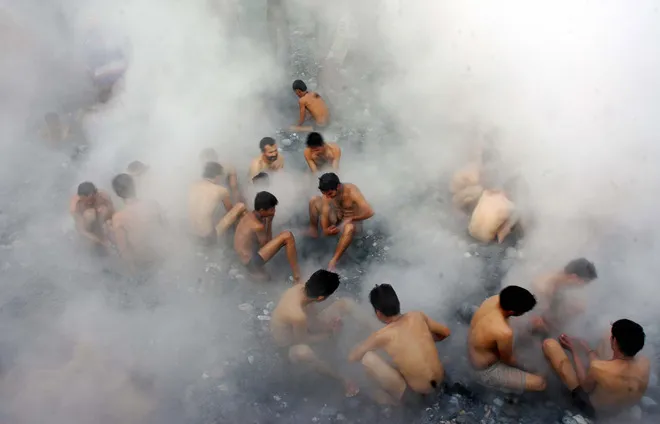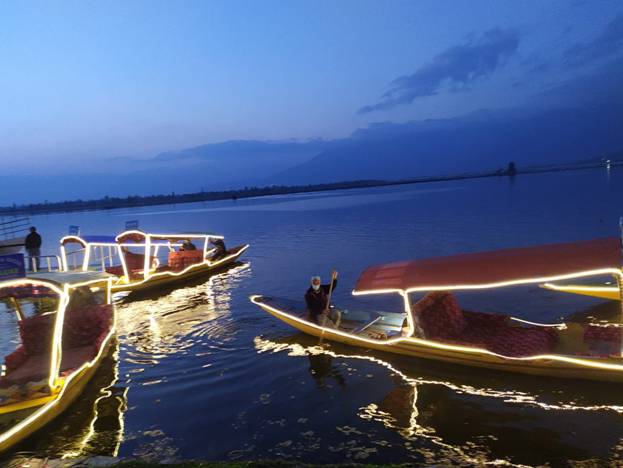Tatapani Hot Spring is a natural geothermal marvel nestled in the Kalakote tehsil of Rajouri district. Revered for its therapeutic and medicinal properties, the spring continuously emits naturally heated sulfur-rich water, believed to offer relief from various ailments
By: Javid Amin | 21 October 2025
Steam over the Hills
In the remote hills of Kalakote tehsil, nestled within the Pir Panjal range of Jammu and Kashmir, lies a natural wonder that has captivated locals and visitors alike for centuries — the Tatapani Hot Spring. The name “Tatapani” translates to “hot water” in the Pahari language, aptly describing the spring’s geothermal essence. Situated approximately 14 kilometers from Kalakote town, this sulfur-rich spring has been a source of healing and spiritual solace for generations.
As dawn breaks over the verdant hills, steam rises from the spring, enveloping the area in a misty embrace. Locals and pilgrims gather around the pools, immersing themselves in the warm waters believed to possess therapeutic properties. The air is filled with a sense of reverence and anticipation, as individuals seek relief from ailments and a connection to the sacred.
Mapping the Miracle: Geography and Setting
Kalakote, a town in Rajouri district, serves as the administrative center for the surrounding villages, including Tatapani. The region is characterized by its rugged terrain, dense forests, and a climate that varies from humid subtropical to dry. The area’s elevation and geographical features contribute to the unique geothermal activity observed at Tatapani.
The spring’s location near the Pir Panjal range places it within a tectonically active zone, influencing its geothermal characteristics. Studies have indicated that the water discharge of the springs varies between 4.3 to 11.8 liters per second, with surface temperatures ranging from 59.2°C to 60.7°C
What’s in a Name: Tatapani’s Origins and Legacy
The etymology of “Tatapani” is rooted in the Pahari language, where “Tatta” means hot and “Pani” means water. This straightforward naming reflects the spring’s most distinguishing feature — its naturally heated waters.
Historically, Tatapani has been a site of cultural and spiritual significance. Ancient texts and oral traditions recount tales of sages and pilgrims who visited the spring seeking purification and healing. The site’s enduring legacy is a testament to its longstanding role in the region’s cultural tapestry.
Under the Surface: The Science of the Springs
The geothermal activity at Tatapani is a result of the area’s unique geological setting. The spring is situated along the apex of active faults, including the Balakot-Bagh Fault, which influences its thermal properties . The presence of sulfur compounds in the water is indicative of the mineral-rich environment, contributing to its therapeutic reputation.
Isotope studies and chemical investigations have provided insights into the spring’s origins and temperature variations. These scientific analyses not only enhance our understanding of the spring’s geothermal characteristics but also underscore the importance of preserving such natural resources.
Faith and Fire: The Spiritual Connection
For the local communities, Tatapani is more than just a natural phenomenon; it is a sacred site. Pilgrims from various parts of Jammu and Kashmir visit the spring, believing in its healing powers. The warm waters are thought to cure ailments ranging from skin diseases to joint pains, drawing individuals seeking both physical relief and spiritual rejuvenation.
Rituals and offerings are common around the spring, with devotees expressing gratitude and seeking blessings. The intertwining of faith and nature at Tatapani highlights the deep-rooted spiritual connection the community shares with this natural wonder.
Healing the Body, Healing the Land: Wellness and Ecology
The therapeutic properties of Tatapani’s waters have attracted wellness enthusiasts and researchers alike. Studies have shown that sulfur-rich springs can aid in the treatment of various dermatological and musculoskeletal conditions . This has led to a growing interest in the potential of the spring as a wellness tourism destination.
However, the influx of visitors poses ecological challenges. Unregulated tourism can lead to pollution and degradation of the surrounding environment. It is imperative to balance the promotion of wellness tourism with sustainable practices to preserve the spring’s natural and ecological integrity.
Lives around the Steam: The Local Economy and Identity
The presence of Tatapani has significantly influenced the local economy and identity. Villagers engage in various activities related to the spring, including guiding pilgrims, selling herbal remedies, and providing accommodations. These livelihoods are deeply intertwined with the spring, making its preservation crucial for the community’s well-being.
Moreover, Tatapani serves as a cultural hub, where traditions and stories are passed down through generations. The spring is not just a source of income but a symbol of the community’s heritage and resilience.
Warning Signs: Environmental Stress and Mismanagement
Despite its significance, Tatapani faces several environmental challenges. The increasing number of visitors has led to littering and pollution, affecting the water quality and surrounding landscapes. Moreover, the lack of proper infrastructure and waste management exacerbates these issues.
In 2024, a tragic incident in a nearby village highlighted the potential dangers of contaminated spring water, underscoring the need for stringent monitoring and management of natural water sources.
Learning from Others: Eco-Tourism and Geothermal Management Models
Other regions with geothermal springs have implemented successful eco-tourism models that balance visitor engagement with environmental conservation. For instance, areas in Himachal Pradesh and Sikkim have established guidelines for sustainable tourism, including waste management protocols and visitor education programs.
By adopting similar strategies, Tatapani can enhance its appeal as a wellness destination while ensuring the preservation of its natural resources.
Future Prospects: Energy, Education, and Sustainability
Beyond tourism, Tatapani holds potential for renewable energy generation. Geothermal energy studies suggest that the region’s thermal resources could be harnessed for sustainable power production.
Educational initiatives focusing on the ecological and cultural significance of Tatapani can foster a sense of stewardship among locals and visitors. Collaborations between government agencies, environmental organizations, and the community can pave the way for a sustainable future for Tatapani.
Bottom-Line: The Steam That Speaks
Tatapani Hot Spring is more than just a natural wonder; it is a testament to the harmonious coexistence of nature, culture, and science. Its warm waters have healed bodies, nurtured spirits, and sustained communities for generations. As we look to the future, it is essential to approach Tatapani with respect and responsibility, ensuring that this sacred spring continues to flow for generations to come.



